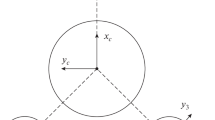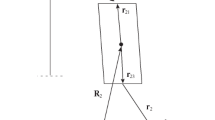Abstract
The baseline pointing dynamics, i.e., the attitude of the instantaneous plane of rotation, of a linear tethered interferometer with single baseline orbiting in an Earth trailing, heliocentric orbit is analyzed. Two tether arms provide a passive control of the spacecraft formation by keeping two light collectors and one combiner aligned while spinning about the boresight of the interferometer. The interferometer optical path delay variation under gravity gradient perturbation and unbalanced solar radiation torque is investigated analytically for a fixed-length dumbbell model. Analytical results are compared with results from numerical simulations of a visco-elastic massive tether model in order to assess the effect of the tether dynamics on the pointing stability of the formation. The study highlights the fundamental role of spin stabilization in counteracting the effect of external perturbation on the interferometer Optical Path Delay (OPD).
Similar content being viewed by others
References
EUROPEAN SPACE AGENCY “DARWIN the Infrared Space Interferometer: Concept and Feasibility Study Report,” Technical Report ESA-SCI (2000) July 12, 2000.
BEICHMAN, C. A., WOOLF, N. J., and LINDENSMITH, C. A. (editors) “Planet Finder,” JPL Publication 99-3, Jet Propulsion Laboratory, Pasadena, California, 1999.
LEISAWITZ, D., et al. “Scientific Motivation and Technology Requirements for the SPIRIT and SPECS Far-infrared/Submillimeter Space Interferometers,” Proceedings SPIE 4013, 2000, p. 36.
CARPENTER, K., et al. “The Stellar Imager (SI) Mission Concept,” Proceedings SPIE 4854, 2002, p. 293.
GENDREAU, K. C., et al. “The MAXIM Pathfinder X-ray Interferometry Mission,” Proceedings SPIE 4851, 2002, p. 353.
BAUER, F. H., et al. “Enabling Spacecraft Formation Flying Through Spaceborne GPS and Enhanced Automation Technologies,” Proceedings of the 1999 ION-GPS Conference, Nashville, TN.
FARLEY, R. E. and QUINN, D. A. “Tethered Formation Configurations: Meeting the Scientific Objectives of Large Aperture and Interferometric Science,” New Concepts for Far-Infrared and Submillimeter Space Astronomy, April 2004, NASA/CP-2003-212233, p. 463–471.
BAINUM, P. M., STUIVER, W., and HARKNESS, R. E. “Stability and Deployment Analysis of a Tethered Orbiting Interferometer Satellite System,” Report TG-1045, Dec. 1968, The Johns Hopkins University, Applied Physics Laboratory, Silver Spring, Maryland.
BAINUM, P. M., HARKNESS, R. E., and STUIVER, W. “Attitude Stability and Damping of a Tethered Orbiting Interferometer Satellite System,” The Journal of the Astronautical Sciences, Vol. XIX, No. 5, pp. 364–389, March–April 1972.
STUIVER, W. and BAINUM, P. M. “A Study of Planar Deployment Control and Libration Damping of a Tethered Orbiting Interferometer Satellite,” The Journal of the Astronautical Sciences, Vol. XX, No. 6, pp. 321–346, May–June 1973.
LABEYRIE, A., et al. “TRIO: A Kilometric Optical Array Controlled by Solar Sails,” AAS Bulletin, Vol. 16, No. 3, 1984, pp. 828–831.
CRELLIN, E. B. “Preliminary Studies of a Spinning Tether Connected Trio Concept,” Proceedings of the Colloquium on Kilometric Optical Arrays in Space, European Space Agency, SP-226, April 1985, p. 91.
DECOU, A. B. “Gravity Gradient Disturbances on Rotating Tethered Systems in Circular Orbit,” Proceedings of the 3rd International Conference on Tethers in Space Toward Flight, San Francisco, CA, May 18, 1989.
MELODY, J. W. and BRIGGS, H. C. “Analysis of Structural and Optical Interactions of the Precision Optical Interferometer in Space (POINTS),” Proceedings of the SPIE Symposium on OE/Aerospace, Science and Sensing, Conference on Spaceborne Interferometry, Vol. 1947, Orlando, FL April 1994, pp. 44–57.
COSMO, M. and LORENZINI, E. C. “Transient Dynamics of the Tether Elevator/Crawler System,” Paper 88-4280-CP presented at the AIAA/AAS Astrodynamics Conference, Minneapolis, MN, August 15–17, 1988.
BELTSKY, V. V. and LEVIN, E. M. “Dynamics of Space Tether Systems,” Advances in the Astronautical Sciences, Vol. 83, Univelt 1993, pp. 340–342.
MEIROVITCH, L. Methods of Analytical Dynamics, McGraw-Hill Book Co., New York, 1970, p. 130.
MCINNES, C. R. Solar Sailing: Technology, Dynamics and Mission Applications, Springer-Verlag Series in Space Science and Technology, 1999, pp. 47–49.
Author information
Authors and Affiliations
Rights and permissions
About this article
Cite this article
Bombardelli, C., Lorenzini, E.C. & Quadrelli, M.B. Formation Pointing Dynamics of Tether-Connected Architecture for Space Interferometry. J of Astronaut Sci 52, 475–493 (2004). https://doi.org/10.1007/BF03546413
Published:
Issue Date:
DOI: https://doi.org/10.1007/BF03546413




